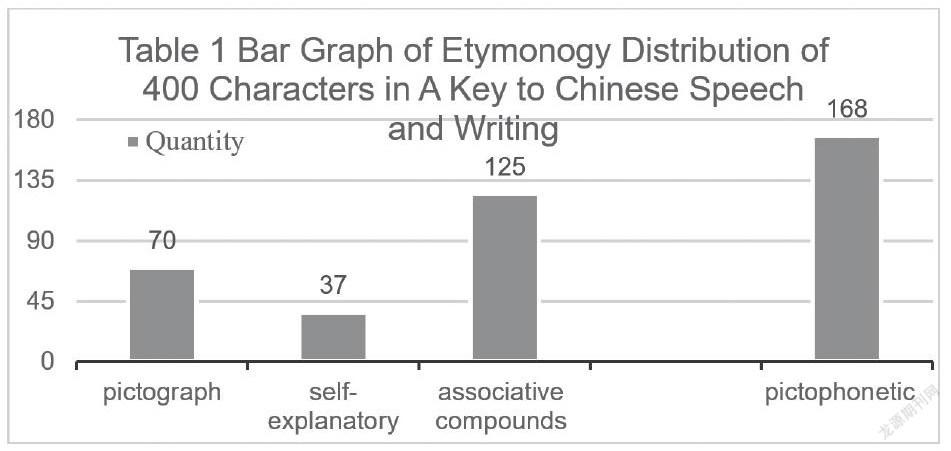Analysis of Character Etymology of the textbook A Key to Chinese Speech and Writing
2019-09-10陈金秋
陈金秋

1 Bref introduction of textbookA Key to Chinese Speech and Writing
The textbook A Key to Chinese Speech and Writing was edited by French sinologists Jo?l Bellassen and Zhang Pengpeng.It was first published in France in 1989 and has been widely praised by the French Chinese teaching community.Working as an enlightenment textbook for Chinese language and characters,the overall design of this textbook strives to reflect the relationship between Chinese characters and words,and aim to teach Chinese according to the original face of Chinese itself.Mainly based on daily communicative language,the texts are rich in content and interspersed with the introduction of Chinese culture,which are very popular among students.
2 Classification of Character Etymology
A Key to Chinese Speech and Writing arranges all the new characters in the whole textbook into a 400-character form according to the pinyin order.
We analyze the etymology of 400 characters in this textbook mainly by looking up two online Chinese corpus systems:Hieroglyphs Dictionary and Han Dian.Through consulting and analyzing,we classify the 400 characters into six classifications.
According to our classification,we organized the six character-formation methods of the 400 Chinese characters in A Key to Chinese Speech and Writing into the above table(Bar Graph of Etymonogy Distribution of 400 Characters in A Key to Chinese Speech and Writing).
As a Chinese textbook for beginners to learn Chinese,the selected Chinese characters are all basic characters in modern Chinese,which is in line with the basic characteristics of universal commonality,stability and strong character-formation ability.Through inductive analysis,it's found that among these commonly used Chinese characters,pictophonetic characters account for the largest proportion and self-explanatory characters occupy the smallest proportion.Among the 400 characters,the number of pictophonetic characters is 168,accounting for 42% of the total;associative compounds rank second 125,accounting for 31% of the total;pictographs amount to 70,accounting for 18% of the total;elf-explanatory characters have the smallest number 37,accounting for 9% of the total.
Overall,both associative compounds and pictophonetic characters occupy a significant proportion in this textbook which is consistent with the continuous and objective development of Chinese characters and there is evidence to follow.Associative compounds are combination of pictographs and self-explanatory characters.It follows that their amount exceeds the other two.Taking the amount of initials in Shuo Wen Jie Zi as the reference,according to the statistics in Wenzi mengqiu written by Wang Yun,a Qing Dynasty scholar,the amount of associative compounds are 1260,accounting for 13.47% of the total;besides statistics from Shuowen tongxun dingsheng written by Zhu Junsheng,a Qing Dynasty scholar,shows 1167,accounting for 12.48% of the total.Later generations are also more willing to create associative compounds such as 淚、歪、尘、灶、体、孙.ect.
Pictophonetic character is a groundbreaking method of creating characters,with the form of the pictopraphs signifying the meaning of the character category and the pronunciation of the phonetic symbols signifying the sound of object name,thus it gets rid of the limit of signifying meaning only by form and satisfies the need of creating characters.With the appearance of a large number of pictophonetic characters,the number of Chinese characters finally meets the needs of Chinese.Pictophonetic character formation method makes use of both the sound and form,which is convenient,flexible and of strong derivative ability of creating large amount of characters.Taking the initials in Shuo Wen Jie Zi as reference,according to statistics from Wenzi mengqiu written by Wang Jun in Qing Dynasty,the number of pictographs is 7700,accounting for 82.33% of the total characters;according to statistics in Shuowen tongxun dingsheng written by Zhu Junsheng in the same dynasty,the number of pictographs is 7697,accounting for 82.29% of the total.Later generations also create lots of pictophonetic characters like the hundreds of terminologies used in modern chemistry,almost all of which are newly coined characters.
3 Conclusion
To sum up,through analyzing the Character Etymology of the textbookA Key to Chinese Speech and Writing,we can see that this textbook take into consideration of the six character-formation methods.Associative compounds and pictophonetic characters both occupy a large proportion in the textbook.
